 About GamePeople
About GamePeople
Subscribe to the Story Gamer column:![]() RSS or
RSS or
![]() Newsletter.
Newsletter.
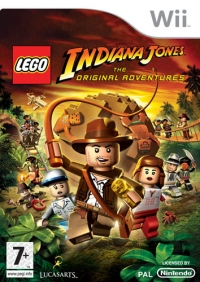
Format:
Nintendo Wii
Genre:
Adventuring
Style:
Thirdperson
Singleplayer
Cooperative
Buy/Support:
Support Mark, click to buy via us...
Other GamePeople columnists have reviewed this from their perspective - huh?:
Teen Gamer (360)
Eclectic Gamer (PS3)
Family Gamer (DS)
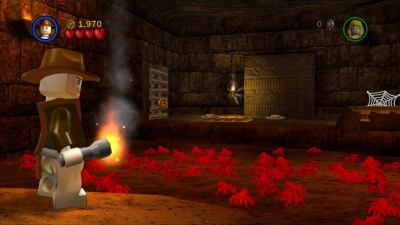
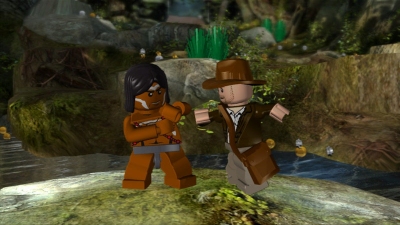
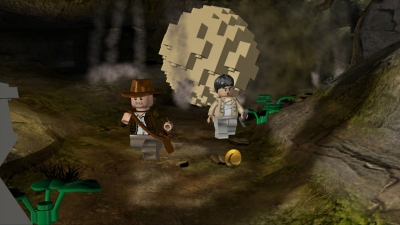
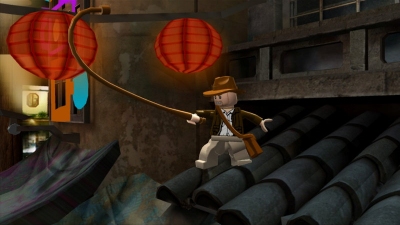

Further reading, films and books that create similar stories:
Lego Indiana Jones: The Original Adventures Wii initially appears to be enjoyable and charming, but on closer inspection the awkward subject matter really isn't a good fit for the Lego series.
While playing Lego Indiana Jones, I found myself thinking about an imaginary Lego Schindler's List. Now, that may seem like a bad taste joke, like the mocked up covers for Lego Human Centipede and so forth you can find online, but in this case I'm being fairly serious.
Lego Schindler's List. It's something I'll come back to.
Basics first: Lego Indiana Jones: The Original Adventures is a mid-period entry in Traveller's Tales Lego series, coming after the first two Lego Star Wars games but before Lego Batman, Lego Harry Potter and this year's Lego Clone Wars and Lego Pirates of the Caribbean.
In adapting the first three Indiana Jones films to the Lego format - action platforming in a Lego-ised world with minifig characters and cute, dialogue-free cut-scenes - Lego Indiana Jones seems a natural sideways step from the previously adapted Star Wars films, Lucasfilm's other Harrison Ford starring action franchise.
On one level, it works just fine. Gameplay is simple, all-ages action, combining puzzles, exploration and the odd bout of fisticuffs. The game engine, while a bit rough around the edges in places - respawns in perilous positions and other weird bugs occasionally frustrate - makes up for that with a lack of fail states and fatalities that means I never had to restart a level.
Controlling Lego Indy with his whip is fun and fluid, although the clunkiness of the nunchuk stick can lead to frustration when more precise steering is needed. While there's nothing too brain-straining the abilities of partner characters, along with a wide range of objects and weapons, need to be fully utilised to progress. For the truly obsessive there's free play mode, and the ability to use a wider range of unlocked characters to access every little nook and cranny of each level to ferret out every treasure and get a 100 per cent complete score.
Level design cleverly opens up set-pieces from the movie, often ones set in contained sound-stage sets, into more sprawling areas to explore, and if nothing else show that there's actually enough material in the films to adapt into a more conventional action game, should LucasArts ever let skilful developers do such a thing.
The super-cute minifig characterisations are lovely. Lego Indy is cocky and stubbly, and if you accidently hit any of the love interests with Indy's whip he'll reel them in for a matinee kiss. The wordless cut scenes are funny and charming, with some great body language and facial expressions to make up for the lack of dialogue. It's hard not to find the Lego-ising of familiar characters and cinematic moments endearing, especially as there seems to be no scene so serious that it can't be twisted to end in a decent sight gag.
The content of the films chafe against the style of presentation, and not in a good way.
(There's a particular pleasure to all this if you're a fan of the kind of British character actors who fill out the secondary roles in these films - when else are you going to get the chance to use phrases like 'Lego Denholm Elliot' or 'Lego Pat Roach', unless they get around to doing Lego Room With A View or Lego Auf Wiedersehn Pet?)
Aside from the amusement value of seeing something familiar turned into a Lego model, there are problems with this particular combination of film series and the Lego brand. The content of the films chafe against the style of presentation, and not necessarily in a good or interesting way.
Lego was, after all, originally designed as a creative, non-violent toy, and while there have been ray guns and swords in Lego sets for ages the on-screen punch-ups and gun-fights of this game feel a step too far. The combat plays well enough - although it does get repetitive, and boss battles can frustrate - but the kind of violence seen in the Indy films sits uneasily with the Lego ethos.
There are also storytelling problems. While the cinematics are certainly sweet, funny and pleasing for fans of the film, I'm not sure they work in terms of actually communicating the beats of each film's story. Really all that's clear from the cut scenes is that in each story Indy and the baddies are both after an object - a box, a stone and a cup respectively - and the wider context of the story is lost.
The narrative of the film honestly doesn't suffer from the dialogue being stripped out.
This has the odd side effect that Temple of Doom, an incoherent mess of a movie that's all over the place in terms of tone, stands out as the clearest in its Lego incarnation, because there really is very little more to the story than chasing the magic stone and freeing a lot of captured children along the way. The narrative of the film honestly doesn't suffer from the dialogue being stripped out and the story being told through mime and the odd diagram. The game version of Temple also manages a far more consistent tone of comic peril than the film's pinballing between horror, slapstick and action set-pieces.
Raiders of the Lost Ark and the Last Crusade less successfully make the transition, partially because their stories are more sprawling and harder to explain, but also because of the nature of the conflict at the heart of them. Both films are set in the 1930s, before the outbreak of World War II, and are about a race to prevent sacred relics falling into the hands of the Nazis.
Except they're not Nazis in the game, they're just 'the enemy', stripped of Swastikas and SS badges but otherwise exactly the same. There are still soldiers in green, officers in black and Toht in his long black coat, but the insignia have gone. Anyone hoping for a meeting with Lego Michael Sheard as Lego Hitler will be sadly disappointed.
Now, this is in many ways a necessary solution to a real problem, as having the trappings of Nazism in a funny little game at least partially aimed at small children just isn't going to fly: aside from the fact it would make the game unreleasable in some countries, it's just inappropriate to throw one of the world's most evil and murderous political regimes into a world of Lego - especially when the nature of these games means the player gets control of every character eventually.
By taking out the context of Nazism, the stories become meaningless.
It's not that you can't use WWII or the Nazi regime in fiction that is fantastical or lightweight or funny, it's just that you need to be aware of what you're doing and the weight of the history and symbolism you're incorporating into your story.
Stripping out the iconography brings its own problems. The baddies in the game, whatever they're referred to as, are clearly Nazis, and playing as a tiny cutesy version of Gestapo agent Major Toht in Free Play mode is just as uncomfortable regardless of the fact his political allegiance is never directly identified.
There's also the larger problem that by taking out the context of Nazism, the stories become meaningless, and the discomfort at the inclusion of a real murderous organisation is replaced by discomfort at the awareness of this absence, and the gaps that leaves in the story.
Star Wars was in many ways a natural fit for Lego, because not only is the world of the films stylised and well-designed in a way that suits cutesy miniaturisation, but the moral context of the story didn't lose anything in being simplified. The enemies in Star Wars are monsters, robots and clones, fantastical soulless creatures who can be dispatched without a thought. The heroes are good, the baddies are evil and that's it.
The Indiana Jones films work differently, and part of the success of the first and third movies is the weight given to the threat by the audience's knowledge of the evils of Nazism and the coming struggles of World War II. While these are adventure films, and no place to contemplate the barely conceivable horror of the holocaust, or the suffering on numerous WWII battlefields, those real life tragedies do provide a context that not only fuels the urgency of the situation - the consequences of the Nazis obtaining powerful magical artefacts are obviously terrible - but also justifies everything that happens to the baddies.
It's unclear why Indy has to fight these guys over shiny antiques.
The Nazis in the Indy movies can be thrown under tanks, blown up, melted or aged to death because they're Nazis, they're avatars of one of, if not the, most evil regime in history. They're fair game. While the films are action fantasies, there's a lot of believably rough action in there, with fist fights and bullets, and the context of how evil the bad guys are is really needed when one of them gets killed under the wheel of a truck or chopped apart by a plane's rotor blades.
Without that context, it's unclear why Indy has to fight these guys over shiny antiques, the power of which is never clear until the cut scene denouements of each story. Without that context, the action seems pretty pointless. Matters are further confused by the Lego world being one where death is both constant - characters are frequently getting smashed to pieces in fights - and irrelevant - not only do the player characters quickly respawn, but cut scenes show decapitated baddies with their heads still alive and such like.
To return to the thought I raised at the start of this review, could you have a Lego Schindler's List?
Well, no, obviously. Aside from the fact that it would be wildly tasteless, it wouldn't work because death has no meaning in the world of Lego. Real life horror and walking bricks don't mix.
I can't help feeling that it probably shouldn't exist.
While the Indiana Jones films aren't Schindler's List - although they do, of course, share a director in Steven Spielberg - Raiders and Last Crusade do use Nazism in their stories, and the horrific realities of the Nazi regime are a background presence that informs the action. Presenting Nazi characters with the branding taken away - off-patent Nazis, if you like - feels queasy. It's taking meaning away from Indiana Jones, and at the same time leaving a distasteful shadow on the bright, breezy world of Lego.
Lego Indiana Jones is in many ways a playable and fun game, I just can't help feeling that it probably shouldn't exist.



Mark Clapham writes the Story Gamer column.
"I love a good story. Games tell many different stories: the stories told through cut scenes and dialogue, but also the stories that emerge through gameplay, the stories players make for themselves."
Here are the games I've been playing recently:
© GamePeople 2006-13 | Contact | Huh?

|
Family Video Game Age Ratings | Home | About | Radio shows | Columnists | Competitions | Contact
With so many different perspectives it can be hard to know where to start - a little like walking into a crowded pub. Sorry about that. But so far we've not found a way to streamline our review output - there's basically too much of it. So, rather than dilute things for newcomers we have decided to live with the hubbub while helping new readers find the columnists they will enjoy. |
Our columnists each focus on a particular perspective and fall into one of the following types of gamers:
|